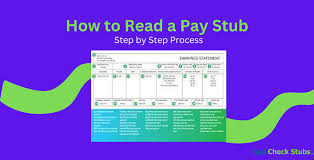Understanding Pay Stubs: Complete 2025 Guide for Employees
Understanding Pay Stubs: Complete 2025 Guide
Understanding pay stubs is essential for every employee who wants full control over their earnings and deductions. Your pay stub reveals exactly how your gross income turns into take-home pay and helps you ensure everything is accurate. Whether you just received your first job or have years of experience, learning how to read and interpret a pay stub is a must for smart financial management.
In this 2025 guide, you’ll discover what a pay stub includes, why it’s important, and how tools like a
pay stub generator
can simplify payroll documentation. We’ll also show you how to check your deductions and use digital pay stubs to keep your records organized. For more details on wage reporting, visit the
Internal Revenue Service (IRS) website or check out our
Payroll Basics
internal guide.
What Is a Pay Stub?
A pay stub, sometimes called a paycheck stub, is a detailed document that lists your total earnings and all deductions for a specific pay period. It breaks down gross pay, taxes, benefits, and net pay. Understanding pay stubs helps you identify exactly where your money goes — from tax withholdings to insurance or retirement contributions.
Employers issue pay stubs to maintain transparency, comply with labor laws, and provide employees with proof of income. You can use your pay stub to verify employment, apply for loans, or track annual income for tax purposes. To learn more about employee wage rights, visit the
U.S. Department of Labor.
Key Elements of a Pay Stub
- Employee and Employer Information: Lists your name, address, and employee ID along with company details.
- Pay Period and Date: Shows the time range worked and the payday.
- Gross Pay: Total earnings before any deductions.
- Deductions: Taxes, Social Security, Medicare, insurance, and other voluntary contributions.
- Net Pay: The amount you actually receive after deductions — your take-home pay.
- Year-to-Date (YTD) Totals: Cumulative record of earnings and deductions for the current year.
Why Understanding Pay Stubs Is Important
Reviewing your pay stub regularly helps you spot errors early, plan your finances, and verify that your employer’s withholdings are correct. It also helps you prepare for tax season without surprises. Keeping a copy of each pay stub—physical or digital—ensures you have financial records ready for applications, audits, or loans.
For freelancers or small business owners, creating accurate stubs is equally critical. You can use tools like a
regular pay stub template
to generate professional records instantly.
Common Mistakes to Avoid When Reading Pay Stubs
- Confusing gross pay with net pay.
- Overlooking tax withholdings and benefit deductions.
- Discarding pay stubs instead of saving them for future reference.
- Not checking YTD totals for consistency.
- Failing to update deductions after changing insurance or W-4 status.
How to Use Pay Stub Tools Effectively
If your employer doesn’t provide pay stubs, online tools are your best option. A
pay stub generator
automatically calculates gross pay, deductions, and net pay with accuracy. It’s also a quick way for freelancers and self-employed workers to maintain legal, well-organized payroll records.
You can also explore our internal guide on
employee tax deductions
to understand how federal and state withholdings affect your paycheck.
Tips for Managing Your Pay Stubs
- Always check your pay stub after every payday for errors.
- Save copies (digital or print) for at least three years.
- Organize them by pay period for easy tax filing.
- Use secure cloud storage for protection and easy access.
- Consult HR or payroll professionals if any discrepancies arise.
Conclusion
In summary, understanding pay stubs is a vital skill for every employee. It helps you track your income, manage taxes, and maintain financial transparency. By regularly reviewing your pay stub, you ensure that every deduction and contribution is accurate. With modern tools like a
pay stub generator
and our internal resources on
financial literacy,
you can take full control of your paycheck and stay financially confident in 2025 and beyond.

